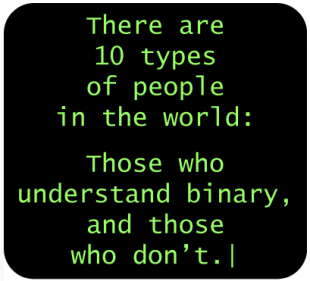 When I was in college pursuing my electrical engineering degree, I had to take a digital logic course. This course taught us how to speak fluently in the only language computers truly understand; binary. Even though I had to build a computer from scratch in this class, I still find it fascinating that flipping a bunch of zeros and ones around can accomplish everything that computers do for us today.
When I was in college pursuing my electrical engineering degree, I had to take a digital logic course. This course taught us how to speak fluently in the only language computers truly understand; binary. Even though I had to build a computer from scratch in this class, I still find it fascinating that flipping a bunch of zeros and ones around can accomplish everything that computers do for us today.
While binary works great for computers, it’s not so great as a marketing strategy. But that’s the way many websites are designed these days.
The Wizard Says, “Go Away!”
 When Dorothy finally reaches the Emerald City in the movie The Wizard of Oz, she’s initially told that the wizard says, “Go away” and then has the door slammed in her face. This is not the way you want to treat website visitors, is it?
When Dorothy finally reaches the Emerald City in the movie The Wizard of Oz, she’s initially told that the wizard says, “Go away” and then has the door slammed in her face. This is not the way you want to treat website visitors, is it?
Then ask yourself this question: “What happens if a visitor is interested in my products or services but isn’t ready to buy right now?” Do you tell them to go away? Or is there another way to stay in touch? Is there middle ground?
If a visitor has only two options – buy or don’t buy – then you’re practicing binary marketing. The only options are for that visitor to become a customer or leave. This means that you could be turning away future customers who aren’t ready to commit today but might be in another week or month or year.
So how do you fix this?
Lead Nurturing
The typical buyer goes through six steps:
- Need recognition
- Information search
- Evaluation
- Choice
- Purchase
- Loyalty
Binary marketing assumes that everyone is already at stage #5. But what if the visitor isn’t at that stage yet? Without a way to capture their interest, you force yourself out of the loop. Implementing a lead nurturing strategy allows you to be present throughout those first four stages and help persuade them to purchase your product or service.
In order to have any hope of executing a lead nurturing program, you’ll need to persuade the visitor to opt into receiving updates from you. Seth Godin believes that:
“Real permission is different from presumed or legalistic permission. Just because you somehow get my email address doesn’t mean you have permission. Just because I don’t complain doesn’t mean you have permission. Just because it’s in the fine print of your privacy policy doesn’t mean it’s permission either. Real permission works like this: if you stop showing up, people complain, they ask where you went.”
You’ll need to determine the timing that makes the most sense for buying cycles in your industry. If you’re selling an ebook or online course, the cycle might be as short as a few days. If you’re selling multi-million dollar enterprise software systems, it’s probably measured in years. So be aware of the length of the buying cycle and adjust your content and touch points accordingly.
Follow up with introductory emails and then offer additional information in the form of ebooks, white papers, videos, etc. Eventually, a personal email or telephone follow up may be in order. Always be sure you’re providing value, otherwise the process will instantly devolve from nurturing to pestering and it will be game over.
Lead nurturing is all about establishing and maintaining a relationship with qualified prospects until they are ready to buy. Keep in mind that 95% of the visitors on your website are performing research and don’t want to engage until the last third of the purchasing process. So make sure you’re not falling into the trap of binary marketing.
